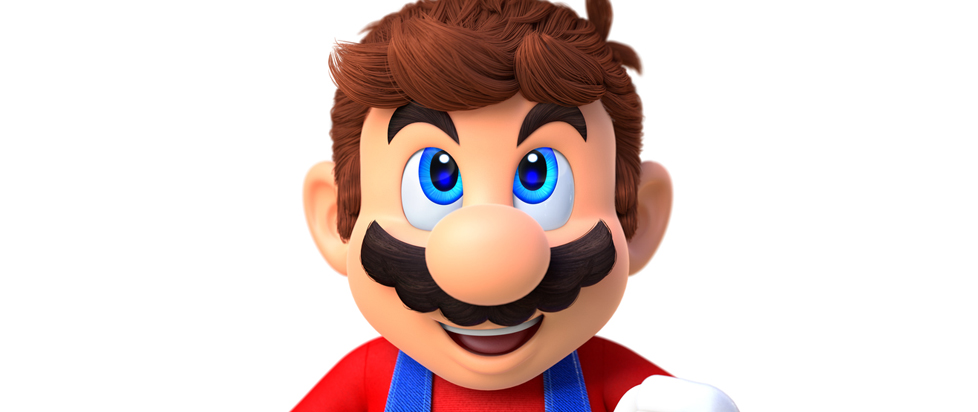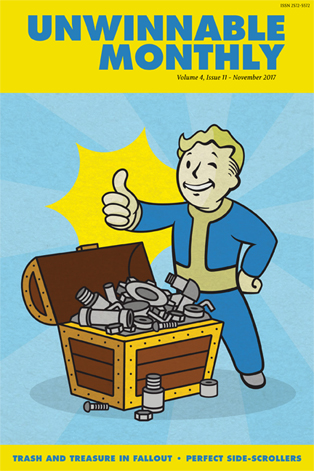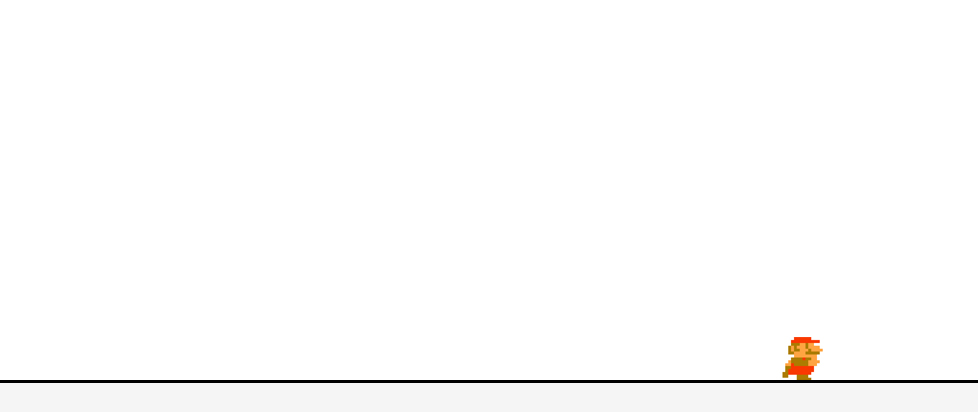
Looking at Mario
 This column is a reprint from Unwinnable Monthly #97. If you like what you see, grab the magazine for less than ten dollars, or subscribe and get all future magazines for half price.
This column is a reprint from Unwinnable Monthly #97. If you like what you see, grab the magazine for less than ten dollars, or subscribe and get all future magazines for half price.
———
Gavin Craig has a lot of games on his shelf that he’s never played. Backlog is his attempt to correct that.
———
I’ve never really understood why Mario has a black mustache and brown hair. On the box art from Super Mario Bros. 3, when the dichotomy first became apparent, it was possible to read the difference as a coloring error, or even as the result of the Super Leaf that has granted Mario an additional set of brown fox ears sprouting from his hat and a matching auburn raccoon tail. Within the 8-bit confines of the in-game graphics, both Mario’s mustache and sideburns are black (and in the cover art for Super Mario Bros. 2, interestingly, they are both a dark brown), but over the years this brown/black combination has become codified, which gives Mario’s moustache something of a Groucho Marx quality. It is fake, the affectation of a child playing dress-up.
Super Mario Bros. was not my first videogame. As near as I can remember, the first games I played were plastic mini-cabinet versions of Pac-Man and Frogger, and the classmate whose parents watched me after school had an Atari 2600 that we used to play Pole Position and Joust. I don’t even remember Super Mario Bros. as my first Nintendo game. Even though it was packaged with the Nintendo Entertainment System my grandparents gave my brother and me for Christmas in 1988, they happened to give us a copy of Dragon Warrior as well, and we loaded that game up first. It was an accidental preference at the time, but it is one I carry to this day.
It is difficult, even for me, to take an unsentimental view of Mario. Even if Super Mario Bros. was neither my first nor my favorite childhood game, it was an experience that my friends and I shared together and talked about when the console was turned off. Even our parents played the game and defeating it conferred a certain briefly indelible renown. Never upon me, of course. I could use the warp zones to cheat my way to World 8, but my death there was almost instantaneous. I didn’t yet understand that the warp zones were intended more as save points than shortcuts, not to allow players to bypass the levels between the first and the last so much as to act as points of return. I don’t think I ever played Worlds 6 or 7, which meant that I never learned the skills or developed the reflexes to survive the final levels. Super Mario Bros. is a masterpiece of design — a game which one is extremely unlikely to beat accidentally.
Even so, as an experience, Super Mario Bros. always struck me as being a bit empty. After seven false castles, rescuing the real princess in the glorious final castle results in a single screen of text and the option to either accept the offer of an effective reverse warp zone, throwing Mario back to an earlier point in the game, or to stand up and turn off the console. There’s no emotional payoff because there’s no narrative setup. The game is all there is and, based on the legacy Nintendo built on these 8-bit foundations, that seems to be more than enough, but there is a lesson in all of this about Mario.
Mario is not a character and he never was. Mario, more so even than most videogame protagonists, is a digital shell into which the player can project herself. Mario has no desires. He has no traits beyond those which are visible and external. He wears a red hat. His hair is brown and his moustache is black. This is what Mario is.
Mario is an ambulatory logo. This is not exactly a secret.
This is why it matters what Mario wears. In an October column criticizing the apparent blindness of popular videogame discourse to the cultural appropriation inherent in a stereotypical sombrero and poncho costume Mario wears in Super Mario Odyssey, David Shimomura notes that the outfit “fails the basic ‘my culture is not a costume’ test.” This, I think, is precisely accurate.
As a non-character, everything that Mario wears is and must be a costume. Furthermore, Mario games frequently make this reality a play mechanic. In the earliest Super Mario games, Mario’s appearance changed as he gained abilities: his size increases when he eats a mushroom and gains the ability to smash brick blocks, and his hat and overalls turn white when he gains the ability to throw fireballs. Starting with Super Mario Bros. 3, however, Mario is able to put on costumes that carry special abilities of their own. This is a subtle but important shift from Mario’s appearance changing as a result of new abilities to new and specialized abilities being the result of Mario changing his appearance.
The majority of Mario’s in-game costumes are based on animals (like the frog, penguin and tanooki suits) or refer to in-game elements such as the Hammer Bros or the Goomba’s Shoe. Even Mario’s overalls and hat can be considered a Mario costume more than any sort of part of even a fictional organic cultural background. No one else in the Mushroom Kingdom dresses like Mario, except for his brother Luigi, whose own comparatively more established character traits (his height, his cowardice) function primarily to establish him as not-Mario.
Mario is a content-free signifier in a fantasy world and even with the best intentions, it would be difficult to respectfully transpose elements of real-world cultures into such an environment. In some sense, the very placement of external cultural markers (especially but not only when these markers are stereotypes) in a fantasy environment is a statement that the culture in question is an appropriate object of fantasy rather than something with meaning on its own terms and in relation to a real social and historical context. I am not trying to argue that it is impossible to respectfully and responsibly take inspiration from other cultures in the construction of fantasy worlds. But the construction of any fantasy is necessarily a fraught and delicate task, and it may be impossible for Mario to be a vehicle for a rich and respectful cross-cultural representation.
A culture, after all, is more than a set of visual markers, and Mario, ultimately, is not.
——–
Gavin Craig is a writer and critic who lives outside of Washington, D.C. Follow him on Twitter @CraigGav.




